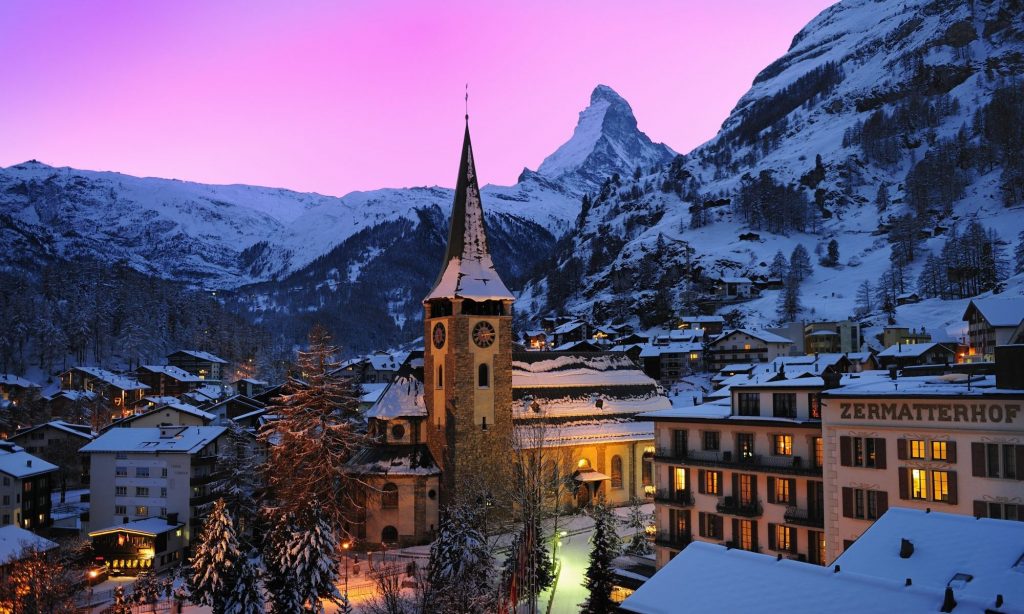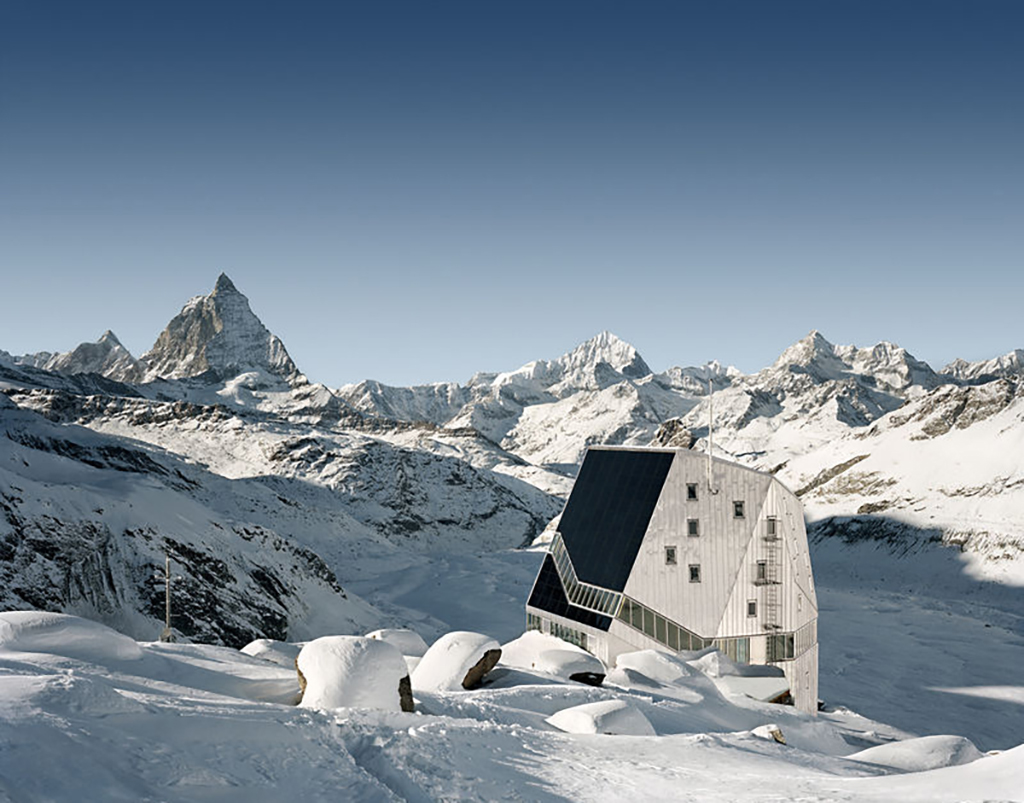Word of Mouth: Zermatt, Switzerland
Within sight of the iconic Matterhorn, hikes, huts, hotels and more

No matter where you look, there it is. It punctuates the cul-de-sac of Bahnhofstrasse, lurks around the corner of every serpentine trail, peeks above centuries-old, rock-roofed barns. It silhouettes iridescent paragliders. And it’s the reason photographers get up before dawn to catch its mirror reflection in glacier lakes. The iconic Matterhorn mountain. With the legendary peak as a backdrop, we spend a week with hiking expert and Architec Apparel founder, Justin Seale, exploring the Swiss town of Zermatt and beyond. The natural feature looms over the car-free hamlet (only electric and horse-drawn conveyances allowed) where we sampled the sites and trails.

Zermatt
Peppered with luxury stores and ski shops, the village of Zermatt, with less than 6,000 people, has long been known as a destination for skiers, climbers headed to the horn, and hikers. Indeed, when spring arrives, Zermatt becomes the nexus of one of the best networks of Alpine hiking trails anywhere, dotted with high-altitude “huts” for weary trekkers too fatigued to pitch a tent every night.
On the streets in town, fashion-forward skiers with Atomics slung over their shoulders, budget backpackers, tanned alpinists with carabiners swinging from their belts, and tourists of every generation and nationality wander around, equally enthralled by the stunning Alpine views. On the town square, the Belle Époque Monte Rosa Hotel still sits. If you want to experience a little of the golden age of alpinism, this is the place. We enjoyed the quiet and simpler accommodations of the Alpenblick Hotel, a family-run establishment whose wooden embellishments and quiet restaurant induced flashbacks of Alfred Hitchcock’s The Lady Vanishes (in a good way).
For some history, there are several culture walks in town with some 30 preserved barns and homes originally dating from the 16th through 18th centuries. Constructed of local larch, the weather-darkened, heavily timbered buildings sit on stanchions of wood that rest on discs of stone designed to prevent mice from climbing into the buildings. At the Matterhorn Museum, visitors can learn about the village’s mountaineering history and the Victorian-era British adventurers who came to town, vying to be the first to summit local mountains. Today, roughly 3,000 people make the climb annually.

Gorner Gorge + Zmutt
A crisp 15-minute walk straight out of town on the Bahnhofstrasse leads to the Gorner Gorge. Before the entrance, plenty of individuals are working selfie sticks to get a shot of themselves with the Matterhorn in the background. The gorge itself is a quiet respite with twisting stairways and wooden railings clinging to the sides of the rock face. It’s a short trek that requires minimal exertion. If you turn right at the end of Bahnhofstrasse, a path leads to alpine meadows dotted with bell-collared cows. The sides of the trail are strewn with fauna both beautiful and rare. There are more than half a dozen flowers unique to the valley, including the spider-like dwarf rampion, a purple flower indigenous to the area since the last Ice Age. (In case you are wondering, don’t eat it. The dwarf rampion is poisonous.) Through forests, the path turns into a 5.8-mile loop hike up to Zmutt, a tiny cluster of houses with a restaurant. At an extra 1,675 feet of elevation, the route makes for a great morning run through the woods, boasting some striking valley views.

Crystal Ride
On the skyline above Zermatt between the Monte Rosa and the Matterhorn is a ridge officially called the Klein Matterhorn (Little Matterhorn), although it’s colloquially known as the Matterhorn Glacier Paradise. Here you’ll find year-round skiing on the Theodul Glacier, which attracts European ski teams that want to train during the summer months. To reach the top, the highest cable car in the world lifts visitors over multiple glaciers to the 12,740-foot summit. Each gondola holds up to 28 people—on heated seats. We suggest the luxury Crystal Ride cars with transparent floors, so you can gaze at the surreal ripples of the frozen rivers of ice below.
At the summit, there are literally breathtaking views of peaks in three countries: Italy, France and Switzerland. Some intrepid souls set off from here to the tackle the Breithorn (13,661 feet), others head to the world’s highest mountaintop restaurant which is fully powered using solar panels and boasts its own wastewater treatment system. If you’re not claustrophobic, you can go under the glacier to explore the ice grotto, replete with ice sculptures and an ice tunnel slide.

Zermatt–Sunnegga Funicular
While the ski hills and trails around Zermatt are festooned with cable car lines, one unique mode of transportation is the zippy funicular up to Sunnegga. It was Switzerland’s first completely underground funicular, but it’s no creaky antique. It was completely modernized about seven years ago and can now carry an upwards of 2,550 passengers per hour. The funicular also seemed to ascend a lot faster than its rated 26mph top speed. When you get to Sunnegga, there’s the Leisee lake to splash around in, plus a marmot viewing station, and a restaurant—with views of the Matterhorn. The funicular is also a quick three-minute ride to get a jump start on the famous 5-Seenweg (Five Lakes Walk), an easy day hike that offers clear views across the valley to the mountain.

Fluhalp Mountain Hut
There are impressive mountain hiking trails all over the world, but Switzerland’s trail advantage (aside from the photogenic panoramas) is its network of huts that offer travelers hot meals, shared bathrooms, and a bunk to crash in. More of a hotel than a hut, the Fluhalp mountain hut sits at an elevation of 8,596 feet and has been family-owned for nearly 130 years. It’s perched next to a dwindling glacier (which is in full retreat now) and above one of the five lakes, the Stellisee. From this spot, visitors find the ultimate portrait of the Matterhorn reflected in its smooth-as-glass surface. After capturing your quintessential dawn reflections of the Matterhorn, trekking around the Fluhalp hikers may encounter a small herd of handsome Valais Blackneck goats. As recently as the 1970s, these long-haired animals were on the verge of extinction. There’s been a turnaround, however, according to Swiss authorities, with over 2,000 Blacknecks now in the area.

Charles Kuonen Suspension Bridge
There’s a certain thrill associated with crossing the 1,621-foot Charles Kuonen Suspension Bridge, the world’s longest pedestrian suspension bridge. Part of that feeling, no doubt, has to do with the fact that to reach it you have hike up 3,281 feet of elevation. The roundtrip trek from Randa, which is about 9 kilometers from Zermatt, takes about five hours. The condition of the trails on the other side of the bridge varies. It’s endured washouts and rock slides, so if you’re planning to use the cross-linked trails to reach the Fluhalp hut, beware that it is not for the faint of heart. Hikers are also warned not to cross the bridge in foul weather due to possible lightning strikes.

Monte Rosa Hut
For some hikers, the ultimate trek will be a sojourn over a glacier. Above Zermatt you’ll find just such a challenge, heading over the Gorner Glacier—the second biggest in the country—to reach the space-age Monte Rosa Hut at 9,459 feet. Getting off the train from Zermatt at the rocky ridge of Gornergrat, hikers strap on crampons to make their way over the ice; an experienced guide is also recommended here. Years ago, the glacier could be crossed easily, but today rapid melting is constantly opening new crevasses, so circumnavigating the sluicing rivers under the ice and crossing the metal bridges that dot the route has become much more challenging.
Hikers are rewarded, after a brief final climb, by reaching the Monte Rosa Hut—so named because its rocky perch lies below the Monte Rosa massif. Reservations are needed at the 120-bed, aluminum sheathed, solar-powered hut (or you can have a snack and then head back across the glacier). Designed by students at ETH Zurich and opened in 2009, the Monte Rosa Hut is an experiment in self-sufficiency and minimal environment impact. And, of course, the views of the Matterhorn are spectacular.
Hero image by John Quain












